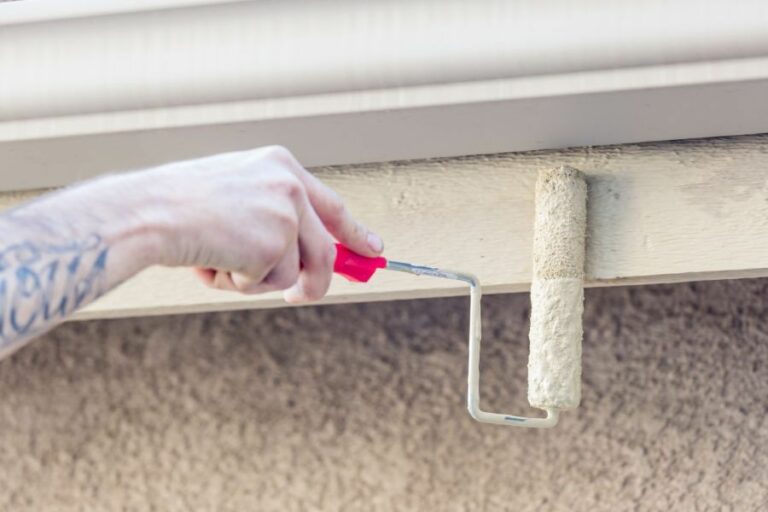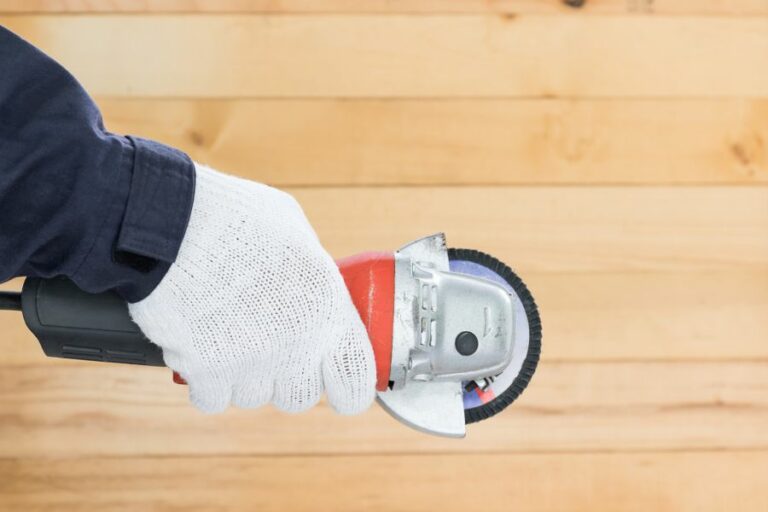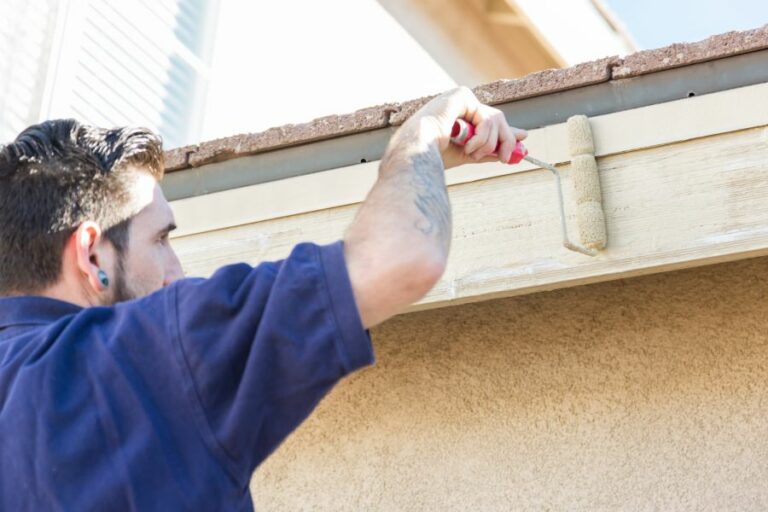Find The Perfect Primer For Your Surface Type. What Pros Say
Are you tired of struggling with uneven and poorly adhered paint jobs? Look no further! Our expertise in surface preparation will help you find the perfect primer for your specific surface type, ensuring a flawless finish every time.
Find the perfect primer for your surface type:
The ideal primer for your surface depends on its material and requirements. For wood, use oil-based or shellac primers; for metal, rust inhibitive or galvanized metal primers; for concrete and masonry, masonry or waterproofer primers; for drywall, drywall primers; and previously painted surfaces, universal primers. Assess the surface and select a suitable product to improve paint adhesion, appearance, and durability.

Ready to find the perfect primer for your surface? No matter what material you’re working with, our expert guide has you covered. Keep reading to discover how to achieve a flawless finish and unlock the full potential of your space. Don’t miss out on these tips and tricks!
Contents
- 1 Discover the Ideal Primer for Your Specific Surface
- 2 Identifying the Right Primer for Various Surfaces
- 3 Primer Suitability for Different Surface Types
- 4 Top Primers for Pre-Painted Surfaces: A Guide
- 5 Choosing Between Oil and Water-Based Primers
Discover the Ideal Primer for Your Specific Surface
A well-chosen primer can significantly improve paint adhesion, prolonging the durability of finishes and creating a smoother, more uniform appearance.
• Understanding Primers and Their Functions
A primer is a preliminary coating applied to a surface before painting, which serves several essential purposes:
- Promote Adhesion: Primers help paint adhere better to the surface, ensuring a longer-lasting finish.
- Improve Appearance: Primers smooth out surface imperfections, creating an even base for the paint and enhancing its color and sheen.
- Provide Better Protection: A quality primer prevents moisture, stains, and other contaminants from affecting the paint, prolonging its lifespan and ability to protect surfaces.
- Block Stains: Certain primers are specifically formulated to seal and block stains, making them ideal for covering watermarks, rust, and discoloration.
With these benefits in mind, let’s explore the best primers for various surface types.
• Primers for Wood Surfaces
Wood, a porous material with irregular surfaces, requires specific primers to achieve an excellent finish. I recommend the following depending on your specific needs:
– Oil-Based Primers
Oil-based primers are excellent for sealing porous surfaces like wood, providing a smooth, even base for painting. They are also effective in preventing tannin bleed, which is the seeping of discoloring chemicals from the wood into the paint.
A reliable oil-based primer for wooden surfaces is the Zinsser Cover Stain Primer.
– Shellac Primers
Shellac primers, derived from natural resins, offer superior stain-blocking capabilities, making them ideal for painting over knotty, resinous woods like pine and cedar. One recommended shellac primer is Zinsser B-I-N.
• Primers for Metal Surfaces
Metal surfaces require primers that prevent corrosion and enhance adhesion, especially when exposed to harsh conditions. Consider these options for metal surfaces:
– Rust Inhibitive Primers
These primers contain anti-corrosive properties that protect surfaces from rust and extend the life of the paint. If you are working with metal surfaces that are prone to rust, I recommend using a rust-inhibitive primer like Rust-Oleum Rusty Metal Primer.
– Galvanized Metal Primers
Galvanized metal, treated with a protective zinc coating, can be challenging to paint, requiring a specialized primer to ensure proper adhesion. KILZ Adhesion High-Bonding Primer is a modified acrylic primer designed for use on galvanized metal and other hard-to-paint surfaces.
• Primers for Concrete & Masonry Surfaces
Concrete and masonry surfaces are porous and can absorb moisture, leading to paint failure. Using the right primer can help mitigate these issues:
– Masonry Primers
Masonry primers penetrate the surface, filling in the pores to create a smoother base for paint. They also reduce the amount of paint required to coat the surface effectively. A recommended masonry primer is Sherwin-Williams Loxon Concrete & Masonry Primer.
– Waterproofer Primers
These primers not only serve as a basecoat but also help prevent water infiltration, perfect for areas exposed to moisture, such as basements and concrete walls. An excellent example of a waterproofer primer is Drylok Latex Base Masonry Waterproofer.
• Primers for Drywall Surfaces
Drywall surfaces are highly porous, and the right primer can help create a uniform finish for better-looking results:
– Drywall Primers
Drywall primers are specifically formulated to seal the porous surface and equalize absorption rates between the paper and joint compound, resulting in a consistent finish. A recommended drywall primer is Glidden PVA Primer.
• Primers for Previously Painted Surfaces
Repainting a surface requires a primer that can improve adhesion and even out different paint types, colors, or sheens. Use a universal primer for previously painted surfaces, such as Benjamin Moore Fresh Start Multi-Purpose Primer.
• Conclusion
Choosing the perfect primer depends on the surface type and specific requirements of your project. Before purchasing a primer, assess the surface carefully, consider its characteristics, and select the most suitable product for optimal results.
In doing so, you will improve the overall appearance and durability of your paint job.
Surface Type | Recommended Primer |
|---|---|
Wood | Oil-based primer |
Metal | Rust-inhibiting primer |
Plastic | Plastic primer |
Brick | Masonry primer |
Concrete | Concrete primer |
Drywall | PVA primer |
Identifying the Right Primer for Various Surfaces
Selecting the appropriate primer for a specific surface is crucial to ensure a successful paint job. Different surface materials require different properties in a primer to achieve optimal results.
• Water-Based (Acrylic) Primer
Water-based or acrylic primers are versatile and can be used on a wide range of surfaces. They are easy to clean up, have low odor, and dry quickly. Due to their flexibility and adhesion properties, they are suitable for both interior and exterior applications.
– When to Use Acrylic Primer
- Drywall: Acrylic primers are ideal for new, unpainted drywall. They readily absorb into the porous surface, providing a smooth and even base for the topcoat while preventing paint from soaking into the drywall. A study published by the Gypsum Association shows the advantages of water-based primer for drywall and its performance in terms of durability and adhesion.
- Plaster: Acrylic primer works well on plaster surfaces by sealing the porous substrate, ensuring an even, consistent finish with the paint.
- Wood: When it comes to bare or painted wood, water-based primers can provide excellent adhesion and prevent tannin bleed (staining due to tannins present in certain woods). Opt for a high-quality acrylic primer that is specifically designed for wood surfaces for the best results.
- Metal: While not every water-based primer is suitable for metal surfaces, some formulations are designed to provide good adhesion and corrosion protection on metal. Always check the product information to ensure the primer is suitable for metal application.
• Oil-Based Primer
Oil-based primers provide excellent adhesion and stain-blocking properties. They penetrate deeply into the surface, creating a strong bond that allows the paint to adhere effectively. The thicker consistency of oil-based primers ensures better coverage and durability.
– When to Use Oil-Based Primer
- Wood: An oil-based primer is an excellent choice for interior and exterior wood surfaces, particularly on softwoods, which can be prone to tannin bleed. When painting over stained or varnished wood, an oil-based primer will seal and block the stain, preventing it from seeping into the fresh paint.
- Metal: Oil-based primers are suitable for metal surfaces, providing excellent rust prevention when applied on ferrous metals like iron and steel. They can also be used on aluminum and galvanized metal surfaces for better adhesion and corrosion resistance.
- Masonry: For interior or exterior masonry surfaces, an oil-based primer can help seal the porous surface, creating a uniform base for paint application.
• Shellac-Based Primer
Shellac-based primers are renowned for their exceptional stain-blocking ability. They are fast-drying and can effectively seal surfaces, preventing odors and stains from seeping through the paint. However, they have a strong odor and require denatured alcohol for cleanup.
– When to Use Shellac-Based Primer
- Severe Stains/Odors: Shellac-based primers are recommended for surfaces with severe stains or odors, such as nicotine, water, fire/smoke damage, or heavy-colored stains.
- Wood Knots and Sap Streaks: These primers are also suitable for sealing wood knots, sap streaks, and tannin bleed on hardwood surfaces, ensuring a uniform finish.
Choosing the right primer for the surface you are working on is essential to achieve a durable, professional-looking paint job. By carefully considering the specific requirements of your project and the properties of each primer type, you can select the appropriate primer to meet your needs.
Always check the manufacturer’s recommendations and follow all application and safety instructions to ensure the best possible results.
Surface Type | Primer Type |
|---|---|
Wood | Oil-based or latex primer |
Metal | Oil-based or epoxy primer |
Concrete | Masonry primer |
Drywall | Latex or PVA primer |
Plastic | Acrylic or latex primer |
Glossy surfaces | Bonding primer |
Primer Suitability for Different Surface Types
When working on a painting project, you may be wondering whether primer is necessary and if it can be applied to any surface. In this comprehensive article, we will discuss the various factors that influence the use of primer and its compatibility with different surfaces.
• What Is Primer, and Why Use It?
Primer is a specialized coating used to prepare surfaces for paint, providing a bond between the surface and the topcoat. It seals porous surfaces, ensuring even coverage and prolonged durability of the paint job. In some cases, it can also block stains and improve the overall finish.
• Types of Primers
Understanding the types of primers will help you determine which is suitable for different surfaces. There are three major types of primers:
- Oil-based Primers: Best for wood surfaces, they provide a smooth base for paint and seal wood knots, stains, and odors. However, they tend to be less flexible and may chip or crack over time.
- Latex-based Primers: Ideal for use on drywall, masonry, and some types of wood, they are water-based, offer excellent flexibility, and are easy to clean up.
- Shellac Primers: Effective at blocking stains and sealing odors, they work well on wood, metal, and plaster surfaces. Shellac primers are fast-drying but have a strong odor, requiring proper ventilation during application.
Now that we’re familiar with the different types of primers, let’s discuss their compatibility with various surfaces.
• Priming Wood Surfaces
Wood is known for its porous nature, making it crucial to use a primer to create a smooth, even surface for paint. Using an oil-based or latex-based primer will help seal the wood and prevent paint from soaking in, ensuring a more uniform finish.
It is recommended to use oil-based primers for exterior wood surfaces, as they offer better durability and resistance to moisture.
• Priming Drywall
New drywall should always be primed before painting to seal the surface and ensure even coverage. Latex-based primers are recommended for drywall, providing a smooth and sealed surface for proper paint adhesion.
• Priming Metal Surfaces
For metal surfaces, it is essential to use a primer specifically designed for metal to prevent rust and ensure proper paint adhesion. Both oil-based and latex-based primers can be used on metal, depending on the specific formulation.
For best results, follow the manufacturer’s recommendations and ensure that the metal surface is clean and free of rust before applying primer.
• Priming Masonry Surfaces
Whether it’s brick, concrete, or stone, masonry surfaces often require a primer to ensure proper paint adhesion and prevent future peeling. Latex-based primers work well on masonry surfaces, but it’s essential to choose a product formulated for the specific type of masonry.
• Priming Plaster Surfaces
Before painting plaster surfaces, it’s essential to determine if the plaster is fully cured. If not, this may affect the adhesion of the paint and result in peeling over time.
Shellac or oil-based primers are recommended for plaster surfaces due to their stain-blocking properties and ability to seal the surface.
• Priming Previously Painted Surfaces
When repainting a surface, it’s important to determine if the existing paint is oil or latex-based.
If you’re painting over oil-based paint, it’s recommended to use a bonding primer formulated for adhesion to ensure the new paint sticks properly. If you’re covering latex-based paint, a latex-based primer will typically work well.
• Science in Paint Primer Selection
For more in-depth research related to primer and surface interaction, visit National Center for Biotechnology Information, a governmental website that provides valuable information.
• Conclusion
While it’s true that primer can be used on most surfaces, it’s essential to use the appropriate type of primer for the specific surface and follow the manufacturer’s recommendations. By taking these factors into account, you can ensure a smooth, even, and long-lasting paint job for your project.
Top Primers for Pre-Painted Surfaces: A Guide
When it comes to repainting a previously painted surface, it is crucial to use a primer that promotes adhesion and creates a favorable foundation for the new paint.
• Multi-Purpose Primer
Multi-purpose primers are versatile and can be used on various surface types, which makes them an excellent choice for previously painted surfaces. These primers are water-based and provide excellent adhesion for the new paint layers. They also help prevent the peeling and cracking of fresh paint.
One of the best multi-purpose primers available in the market is Zinsser Bulls Eye 1-2-3. This primer is ideal for both interior and exterior surfaces and provides excellent adhesion, hiding power, and durability.
• Oil-Based Primer
Oil-based primers are another great option for previously painted surfaces. They offer excellent adhesion and stain-blocking properties, and provide a smooth surface for the new paint layer. These primers are particularly useful for surfaces with stains, tannins, or high gloss finishes.
KILZ Original is a popular oil-based primer that can be used on a wide range of surfaces. It offers excellent adhesion, drying time, and coverage. However, ensure that you have adequate ventilation while using oil-based primers, as the fumes can be harmful if inhaled.
• Bonding Primer
If you are working on a surface that has poor adhesion, using a bonding primer is an absolute must. These primers are specifically designed to adhere to challenging surfaces like glossy paints, tiles, and even PVC.
One highly recommended product in this category is the Benjamin Moore INSL-X Stix Waterborne Bonding Primer. This primer is easy to apply, dries quickly, and provides excellent adhesion, ensuring a long-lasting finish for your paint job.
• Stain-Blocking Primer
If you are dealing with stains or discolored areas on the previously painted surface, it is essential to use a primer with stain-blocking properties to prevent the stains from bleeding through the new paint.
B-I-N by Zinsser is an excellent shellac-based stain-blocking primer that can effectively seal off any stubborn stains and provide a suitable surface for the new paint.
This primer is designed for use on both interior and exterior surfaces and is another valuable option to consider when dealing with stained surfaces.
• Choosing the Right Primer for Your Project
Before selecting a primer, it is crucial to evaluate the surface you are working on and consider factors such as surface type, existing paint condition, and the presence of stains. Here are a few tips to help you make the right choice:
- Analyze the surface: Determine the type of surface to be painted (wood, metal, plastic, etc.) and the current paint condition (peeling, cracking, glossy, etc.). This will help you decide which primer is best suited for the job.
- Check compatibility: Ensure that the primer you choose is compatible with the new paint you intend to use. Most manufacturers provide information about the compatibility of their products.
- Consider stains: If the surface has stains or discolored areas that could impact the new paint finish, using a stain-blocking primer is necessary.
- Test the primer: Before committing to a specific primer, it is recommended that you do a test patch on a small area of the previously painted surface. This will help you determine if the primer provides sufficient adhesion and coverage.
- Consult a professional: If you need additional guidance, consult a professional painter or visit a local paint store for expert advice.
In conclusion, choosing the right primer for a previously painted surface is an essential step in achieving a durable and long-lasting finish. Considering factors such as surface type, existing paint condition, and the presence of stains will help you determine which primer is best suited for your project.
With numerous options available, including multi-purpose, oil-based, bonding, and stain-blocking primers, you can confidently tackle any paint job irrespective of the surface conditions.
For further information on primers and their uses, visit The Scientific World Journal’s article on the subject.
Primer Name | Manufacturer | Type | Features |
|---|---|---|---|
Zinsser Bulls Eye 1-2-3 Primer | Zinsser | Water-based | Universal, Low-VOC, Stain Blocking |
KILZ Premium High-Hide Stain Blocking Primer | KILZ | Water-based | High-Hide, Stain Blocking, Mildew Resistant |
Zinsser Cover Stain Oil-Based Primer | Zinsser | Oil-based | Interior/Exterior, Stain Blocking, Fast Drying |
Rust-Oleum Clean Metal Primer | Rust-Oleum | Oil-based | Metal Surfaces, Rust Prevention, Durable |
KILZ Restoration Primer | KILZ | Water-based | Odor Sealing, Stain Blocking, Restoration Work |
Choosing Between Oil and Water-Based Primers
Deciding whether to use an oil or water-based primer for your next painting project can be a daunting task. After all, both types of primers have their own set of advantages and disadvantages.
However, by understanding the key differences between the two, you can choose the best option for your specific needs.
• Understanding Oil-Based Primers
Oil-based primers, also known as solvent-based primers, are made from a mixture of oils and other solvents. These primers are known for their excellent adhesion, stain-blocking capabilities, and durability.
Here are some key benefits of using oil-based primers:
– Superior Stain Blocking
Oil-based primers excel at blocking many types of stains, including water, smoke, and grease stains. This makes them an ideal choice for surfaces with heavy or stubborn stains that can bleed through paint. When dealing with such stains, I recommend using an oil-based primer for the best results.
– Excellent Adhesion
Oil-based primers adhere extremely well to a variety of surfaces, such as wood, metal, and even glossy surfaces. This strong adhesion helps to prevent peeling and chipping of the paint. If you’re painting over a difficult or slick surface, consider using an oil-based primer.
– Durability
Oil-based primers are known for their long-lasting durability, especially in areas exposed to moisture or high humidity. In fact, they are often used as a rust inhibitor on metal surfaces. For projects where extra durability is needed, oil-based primers are a safe bet.
However, there are some downsides to using oil-based primers. These include:
- Longer drying time
- Strong odors
- Difficult cleanup (requires the use of mineral spirits or other solvents)
- Environmental concerns (contains high levels of volatile organic compounds or VOCs)
• Understanding Water-Based Primers
Water-based primers, also referred to as latex or acrylic primers, are made from a combination of water, acrylic resins, and other materials. They have become increasingly popular in recent years due to their ease of use and environmental benefits.
Here are some advantages of using water-based primers:
– Faster Drying Time
Water-based primers dry much faster than oil-based primers, which can be beneficial when working on a time-sensitive project. This also means that you can apply your topcoat sooner, speeding up the overall painting process.
– Low Odor
Unlike oil-based primers, water-based primers have a low odor, making them more pleasant to work with, especially in enclosed spaces.
– Easy Cleanup
Cleaning up after using a water-based primer is a breeze, as it only requires water and soap—no need for harsh chemicals or solvents.
– Environmentally Friendly
Water-based primers are known for their lower VOC content, making them a more environmentally friendly option compared to oil-based primers.
However, water-based primers may not be the best choice for every situation. Some disadvantages include:
- Limited stain-blocking capabilities
- Less adhesion on certain surfaces
- Potential for raised grain on wood
• Personal Recommendations and Final Thoughts
As someone with experience in painting projects, I recommend using an oil-based primer when dealing with heavy stains, difficult surfaces, or when extra durability is required. On the other hand, consider using a water-based primer for less problematic surfaces or when environmental concerns are a priority.
For more information on choosing the right primer, check out this article from This Old House, which provides additional insight on the topic.
In conclusion, whether to use an oil or water-based primer ultimately depends on your specific project needs and personal preferences. By understanding the pros and cons of each type, you can make an informed decision and achieve the best results for your painting project.







